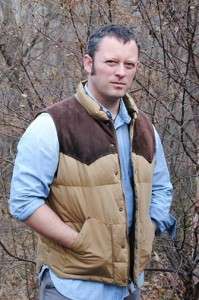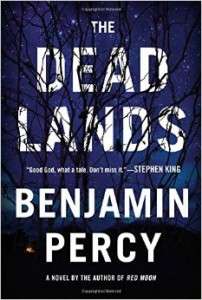The Dead Lands
Benjamin Percy
Grand Central Publishing
Release Date: April 14, 2015
ISBN 978-1-4555-2824-0
When author Stephen King endorses a newly released book with, “Good God, what a tale. Don’t miss it,” a reader has a pretty good indication that they’re in for a ride.
He was right.
Benjamin Percy’s The Dead Lands is yet another post-apocalyptic thriller set after a pandemic has decimated the human race. But don’t let that rote description deter you from reading this suspenseful and entertaining book. To say The Dead Lands is about the post-apocalypse is like saying The Lord of the Rings is about a megalomaniac bent on world domination. That may set the stage but there is oh, so much more to the story, such as an epic quest involving a harrowing journey, mutant monsters, magic, love, and yes, cruelty, horror and heartbreak.
It’s been 150 years since the flu hit the American Midwest. No one knows the origins of the virus; perhaps sabotage, perhaps an accident gone horribly wrong, perhaps simply the way of things. But it started near the USDA labs in Ames, Iowa, and before anyone knew what was happening it had spread to Minnesota, to Wisconsin, to Illinois and Missouri, beyond. Where the flu hit, infrastructure crumbled, electricity died, panic ensued.
Then things got worse.
Then the horizon flashed, the air trembled, as if beset by constant thunderstorms. These were nuclear warheads. China was the first to fire. Then Russia. The United States responded in turn. And soon Britain and India joined them. The missiles scorched the sky, made blackened craters out of cities. When New York and then Boston vanished in a fiery pulse, the Atlantic Ocean poured into their smoldering craters and the steam of millions of ghosts blurred the sky. The nukes were meant as a last-ditch inoculation, to cease the spread of the virus, but they only hurried along the death of the world.
Now, a few thousand souls whose forbearers survived the pandemic and the nuclear strikes exist in an enclosure surrounding what used to be downtown Saint Louis. Named Sanctuary, it’s primitive and dirty yet self-sustaining, with “laws, elections, currency, farms, wells, markets, a hospital, a prison, even a museum that offers the vestiges of the lost world.” Outside the walls of Sanctuary are the Dead Lands, a desert-like wasteland full of mutated horrors and living nightmares.
Not that life in Sanctuary is a picnic, either. Lingering nuclear fallout ensures that cancers and genetic mutations are rampant in the population. It hasn’t rained in months and the wells are drying up for the first time in generations. The new Mayor makes promises but never seems to act on anything and his deputies quell public unrest with increasing brutality. But worst of all is how small the world is for those born in Sanctuary – their entire lives are spent inside the walls with no chance of escape, no sense of freedom, no change from one day to the next. No one is allowed outside the gates of the city; no one, except for sanctioned rangers, and those who have been sentenced to death via the fangs and talons of the mutated creatures who rule the Dead Lands.
Then one day a mysterious girl shows up on horseback outside the gates of Sanctuary – a stranger, a mutant, with eyes that are completely black. She is immediately suspect: an agitator, a terrorist, someone to upset the way of things. Before she can even state how or why she is there, she is taken down by arrows, thrown into prison, slated for execution.
But to sentinel Wilhelmina Clark – who goes only by Clark – this is an opportunity to put a plan in motion. For some time now, Clark has been plotting to leave Sanctuary, to find out what lies beyond its walls, to discover whether or not anything lives beyond the Dead Lands. Now she has proof that there are others out there, proof in this dark eyed mutant girl named Gawea who comes from a mysterious place known as Oregon.
Clark and her half-brother York free Gawea and slip out of Sanctuary to join the others in their party: Reed, a ranger and Clark’s sometimes lover, an older woman known only as the doctor, and Meriwether Lewis, the curator of the museum who knows more about everything than anyone else and who proves to be the pivot on which the story spins. Gawea has promised to lead them to Oregon, a populated land she says is green and rich and thriving. The expedition has no idea of the dangers that lie before them, and only a scant idea of what dangers lie behind them. But they never considered the dangers that lay within them.
It’s hard to put The Dead Lands into a tidy category. It is set in a dystopian future, so that suggests it is the speculative branch of science fiction. It incorporates superstition, legend, magic and an epic journey, which smacks of fantasy. While there is no direct parallel between events in The Dead Lands and the Lewis and Clark Expedition of the early 1800s, the knowing nods between them give the story an interesting – and clever – historical dimension. There is mystery, and action, and thrilling twists and turns, especially with the characters that remain in Sanctuary after Clark and her company slip away. And there are monsters, suspense and terror, and more than a smidgen of blood and gore and cruelty to assuage the tastes of any horror aficionado.
It might seem like a novel with that many stylistic threads would be confusing and chaotic, but author Benjamin Percy keeps the rustic grit of his dystopian world at the core of the story, which grounds it and gives it an unblinking legitimacy; the narrative is never allowed to fritter off into cosmic shenanigans, there is no cavalry waiting just over the hill. All the action is brass tacks; sentimentality will get you killed. Death does not always come to those who deserve it , but it does come, and it is not precise and antiseptic, but brutal and messy, and sometimes agonizingly prolonged and cruel. In this world, no one would expect anything else.
And yet, and yet there is also a current of hope that runs through the narrative. It is hope that spurs Clark and company on when it seems like all is lost, it is what drives them into the Dead Lands in the first place, more than curiosity, more than wanderlust. Hope for a better life, for a realization of worth, for fulfillment of a destiny. Hope for those left behind in Sanctuary. Hope for America. Hope for the world. But with so much betrayal, with so much corruption, with so much harshness within and without, it may just be a fool’s hope after all.
To find out, you’ll have to read The Dead Lands for yourself. But that shouldn’t be a tough call. After all, Stephen King was right, indeed. Good God, what a tale. Don’t miss it.

